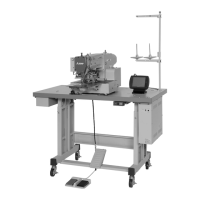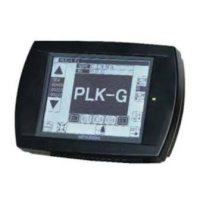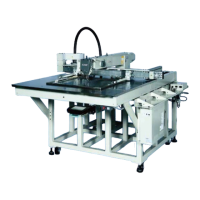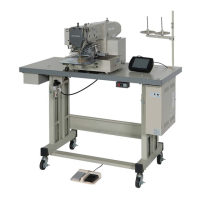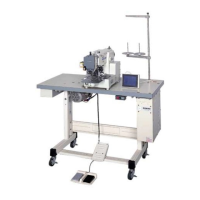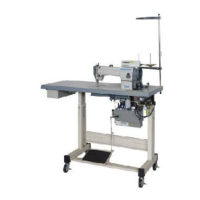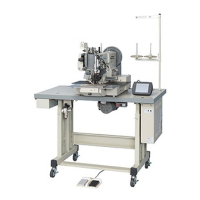
Do you have a question about the Mitsubishi Electric PLK-G2008H and is the answer not in the manual?
| Brand | Mitsubishi Electric |
|---|---|
| Model | PLK-G2008H |
| Category | Sewing Machine |
| Language | English |
Defines DANGER and CAUTION levels for hazardous conditions.
Lists and explains specific caution symbols used in the manual.
Specifies environmental conditions to avoid for safe operation.
Provides safety guidelines for installing the sewing machine.
Key safety measures to observe during sewing operations.
Essential safety measures for machine adjustments.
Covers basic sewing, halt switch, teaching, and pre-heating.
Configuration for alternating clamps and thermal trimming operations.
Detailed steps for adjusting upper and bobbin thread tensions.
Adjustments for shuttle, needle, and presser foot alignment.
Setting needle-shuttle, needle-driver clearances, and timing.
Using test mode and checking sensor signals.
Adjusting trimming components, tension, and timing belts.
Adjusting home position, discs, and mechanical settings.
Diagram identifying the primary components of the sewing machine.
Details on model, sewing speed, dimensions, and mass.
Information on needles, lubrication, drive systems, and power.
Steps for preparing the table and steel stand for assembly.
Instructions for installing motor, control box, and operation panel.
Wiring and connecting the power and foot switches.
Mounting the oil pan and sewing machine head.
Installing the V-belt and connecting electric cables.
Fixing and organizing cables with clips and staples.
Attaching belt cover and assembling thread stand.
Connecting the air tubes for the pneumatic system.
Identifying lubrication points and safety during oiling.
Setting model/language and initializing the setting table.
Loading setting and step files from USB memory.
Guide to creating a USB memory for initial configuration.
Steps for copying configuration data to USB memory.
Procedure for safely installing or replacing the needle.
Instructions for threading the upper thread correctly.
Steps for winding thread onto the bobbin.
Guide to removing and setting the bobbin correctly.
Operating the machine, halt switch, and teaching functions.
Managing pre-heating, clamps, and thermal trimming.
Detailed steps for adjusting upper and bobbin thread tensions.
How to cancel sewing and adjust start position.
Specifics on pattern input and thermal trimming codes.
Understanding pre-heating behavior based on function codes.
Setting up left/right alternating clamp functionality.
Configuring clamp priority and step clamp movement.
Setting input signals for I/O customization.
Switch usage for manual/test mode and thermal trimming.
Adjusting bobbin and upper thread tensions for balance.
Adjusting shuttle position and aligning needle with shuttle.
Setting needle bar height and needle-shuttle clearance.
Fine-tuning clearances between needle, shuttle, and driver.
How to enter the test mode for diagnostics.
Setting clearance between needle and driver guard.
Understanding test mode keys and checking input signals.
Steps to resolve issues encountered in test mode.
Detailed functions of keys in test mode for trimming equipment.
Order of operations and conditions for thermal trimming.
Confirming ON/OFF status of various input signals.
Adjusting the driving shaft arm and presser foot position.
Setting presser foot cylinder sensor and tension release.
Steps for setting the thread puller for trimming.
Configuring thickness detector and thread wiper.
Positioning the upper thread heater and checking sensors.
Adjusting the lower thread trimmer heater and sensors.
Adjusting bobbin thread amount and work holder pressure.
Adjusting thread take-up spring tension and position discs.
Checking hook position and adjusting mechanical home position.
Adjusting the home position for X and Y axes.
Adjusting tension for X and Y axis timing belts.
Procedure for adjusting the X-axis timing belt tension.
Procedure for adjusting the Y-axis timing belt tension.
Instructions for cleaning parts and recommended lubricants.
Proper methods for disposing of waste oil.
Causes and corrective actions for frequent thread breakage.
Troubleshooting problems with upper thread pulling out.
Resolving problems with trimming functions not working.
Issues with bobbin removal and skipped stitches.
Troubleshooting loose stitches and machine non-operation.
Resolving problems with home position and work holder.
Addressing issues causing distorted sewing patterns.
Mapping of solenoid signals and connections.
Diagrams for control box and sensor connections.
Wiring diagrams for power switch to relay across voltage configurations.
Table detailing input terminal signals and their functions.
Table detailing output terminal signals and their functions.
Description and wiring diagram for the expanded I/O port.
Diagrams of TE2 and TE1 connector pinouts.
Detailed pin numbers for various connectors (CON1, SEN1, SEN2, CON N).
Specifications for TE2 input and TE1 output ports.
Time chart illustrating the sequence of trimming operations.
Diagram of table cut-outs and list of table/stand parts.
Identification of parts requiring anaerobic adhesive for assembly.
